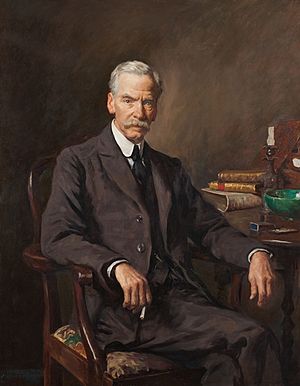Basil Mott facts for kids

Sir Basil Mott (born September 16, 1859 – died September 7, 1938) was a very important English civil engineer. He lived during the late 1800s and early 1900s. He was known for his amazing work on tunnels and bridges in the United Kingdom. Many of his projects happened around the time of World War I.
Contents
Early Life and First Jobs
Basil Mott was born in Leicester on September 16, 1859. He went to school in Switzerland and later studied at the Royal School of Mines. There, he won a special award called the Murchison medal in 1879.
His first job was as a mining engineer. But in 1886, he got a big opportunity. He was asked to join the team building the City & South London Railway (C&SLR). This was one of the first underground railways. Working on this project made him love building things underground. This passion stayed with him for the rest of his career.
Basil Mott did very well at the C&SLR. He was promoted to look after the building of new parts of the railway. He even became the main engineer for the whole line. After the railway opened in 1890, he continued to work for the company. He developed smart ways to fix and rebuild parts of the tunnels at night. These methods are still used on the London Underground today!
After his boss, J. H. Greathead, passed away, Basil Mott teamed up with another famous engineer, Benjamin Baker. Together, they designed the Central London Railway. They also worked on extending and improving the C&SLR. One big project was making sure St Mary Woolnoth church didn't sink while tunnels were built underneath it. They also made Blackfriars Bridge wider. They worked together until Baker's death in 1907.
Mott, Hay and Anderson: A Famous Partnership
In 1902, Basil Mott started a new partnership with David Hay. This team became known as Mott and Hay. Today, the company is called Mott MacDonald.
This partnership worked on many important projects. They helped extend the Central London Railway. They also designed and built escalators for the London Underground. They even worked on famous bridges like the Tyne Bridge and Southwark Bridge. They also helped to make Clifford's Tower in York stable.
During World War I, Basil Mott traveled to France and India. He gave advice to the government on how to solve engineering problems. For his help, he was given a special honor in 1918.
Building the Mersey Tunnel
One of Basil Mott's most famous projects was the Mersey Tunnel. He worked on it from 1922 to 1934. This tunnel was designed to be huge from the very beginning. It is still the longest and widest road tunnel in Great Britain! Basil Mott was the main engineer for this massive project. His company, Mott, Hay and Anderson, designed and watched over the entire construction.
In 1924, he was chosen to be the President of the Institution of Civil Engineers. This is a very high honor for an engineer.
He also helped the city of Southampton in 1926. He looked into different ways to build a crossing over the River Itchen. He suggested building a low bridge that could open up to let boats pass.
Other Important Works
After World War I, Basil Mott continued his busy work. He helped extend the Northern line to Morden. He also made the original C&SLR tunnels wider. He used a special tunneling machine that could work at night. This machine even allowed trains to pass through during the day! He also worked on the Jubilee Bridge and the Tees Newport Bridge.
In 1930, when he was 71, he shared his knowledge about a plan for a Channel Tunnel. This tunnel was not built at that time. However, Mott, Hay and Anderson later designed a successful plan for the Channel Tunnel many years later. In the same year, he was given the title of baronet.
In May 1932, he became a Fellow of the Royal Society. This is a very special award for scientists and engineers.
Basil Mott passed away on September 7, 1938, in London. His great-grandson, David Hugh Mott, holds the baronetcy today.

